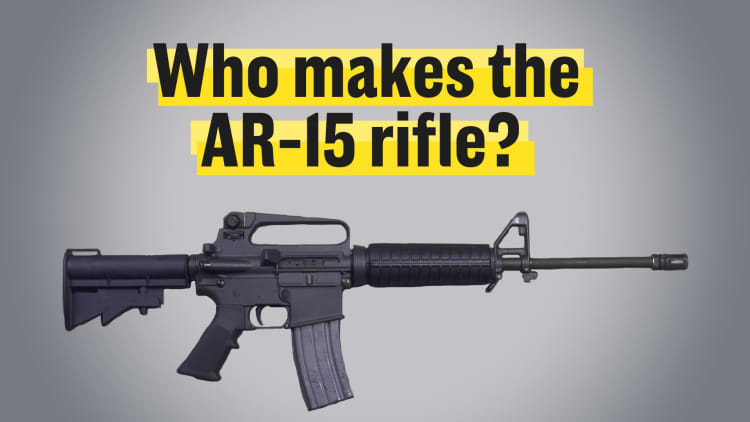
Following last week's Florida school killings, there's movement by gun control advocates in some states to ban so-called assault weapons.
Yet exactly what constitutes an "assault weapon" is a contentious issue and something that riles up some gun advocates. In fact, many of the large gun groups consider "assault weapon" a made up and ambiguous term invented by the anti-gun lobby in the 1980s, maintaining that guns don't actually "assault" people.
That said, the gun industry's traditional definition of an "assault rifle" is a weapon the military generally uses and has "select fire capabilities," or the capability to switch between semi-automatic or a fully automatic mode. However, the civilian AR-15s do not have the select fire capabilities, only semi-automatic settings, so the firearms industry insists they are not an actual assault rifle or assault weapon.
To be clear, though, the federal government usually refers to a military-style weapon capable of firing multiple rounds, either semi-automatic or a fully automatic firearm.
Regardless, the controversy over the AR-15-style rifle stems from its widespread use in some of the nation's worst mass shootings.
The AR-15 weapon used by accused shooter Nikolas Cruz at a high school in Parkland, Florida, is a semi-automatic version of the U.S. military's M-16 rifle and was included in a ten-year ban signed into law by President Bill Clinton in 1994. That law also banned the semi-automatic weapons used in other mass shootings, including the Oct. 1 massacre in Las Vegas and the 2012 shooting in Newtown, Connecticut.
The National Shooting Sports Foundation, the firearms industry trade association, points out on its website that the "AR" actually doesn't stand for assault rifle or automatic rifle but dates back to the 1950s and refers to the company that developed the weapon system, Armalite Rifle.
"AR-15-style rifles are NOT 'assault weapons' or 'assault rifles,' according to NSSF's website. "An assault rifle is fully automatic — a machine gun. Automatic firearms have been severely restricted from civilian ownership since 1934."
The NSSF added, "AR-15-style rifles look like military rifles, such as the M-16, but function like other semi-automatic civilian sporting firearms, firing only one round with each pull of the trigger."
States also tend to have different definitions in gun laws for what is an assault weapon or assault rifle, and it often changes when lawmakers seek to close what they perceive as loopholes.
For one, California's gun laws changed this year so that certain AR-15 rifles with so-called bullet buttons are no longer exempt from an earlier assault weapons ban and now must modified. Lawful owners, though, are allowed to keep the weapon if they register it.
There is also proposed legislation in Ohio that would limit the AR-15. The state's Republican governor, John Kasich, said Sunday he wanted a way to curb sales of the "God-darn AR-15" but the bill also could impact the sale statewide of all semi-automatic weapons.
The National Rifle Association declined requests for an interview but on its website it defends the AR-15s as "the most commonly used rifles in marksmanship competitions, training and home defense." It also said more than 15 million AR-15s are owned by Americans today.
The Ohio bill defines an assault weapon as "an automatic firearm that has not been rendered permanently inoperable, a semi-automatic firearm capable of accepting a detachable magazine with the capacity to accept ten or more cartridges, and a semi-automatic firearm with a fixed magazine with the capacity to accept ten or more cartridges."
At the same time, there's more pressure on lawmakers in Florida to pass gun legislation. Earlier attempts after the 2016 mass shooting at the Pulse nightclub in Orlando failed.
The 1994 federal assault weapons ban, officially known as the Public Safety and Recreational Firearms Use Protection Act, was passed as a crime-fighting bill and identified more than a dozen specific models of firearms, including the Colt AR-15, that were defined as semi-automatic assault weapons. It also defined the term by specific characteristics, such as the ability to accept a detachable magazine and by certain cosmetic features.
Even so, the 1994 ban also excluded semi-automatic rifles that couldn't accept a detachable magazine holding more than five rounds of ammunition as well as around 650 guns that were considered primarily used in hunting and recreational sports, including Browning, Remington and Berettas.
After the deadly Newtown shootings at Sandy Hook Elementary School, there was a attempt to pass another assault weapons ban by Democrats but it failed. The 2013 gun legislation would have banned nearly 160 specific firearms and further defined what constituted a "semi-automatic assault weapon." Moreover, it also would have banned parts or devices to the firearms that accelerated the rate of semi-automatic rifle fire.


